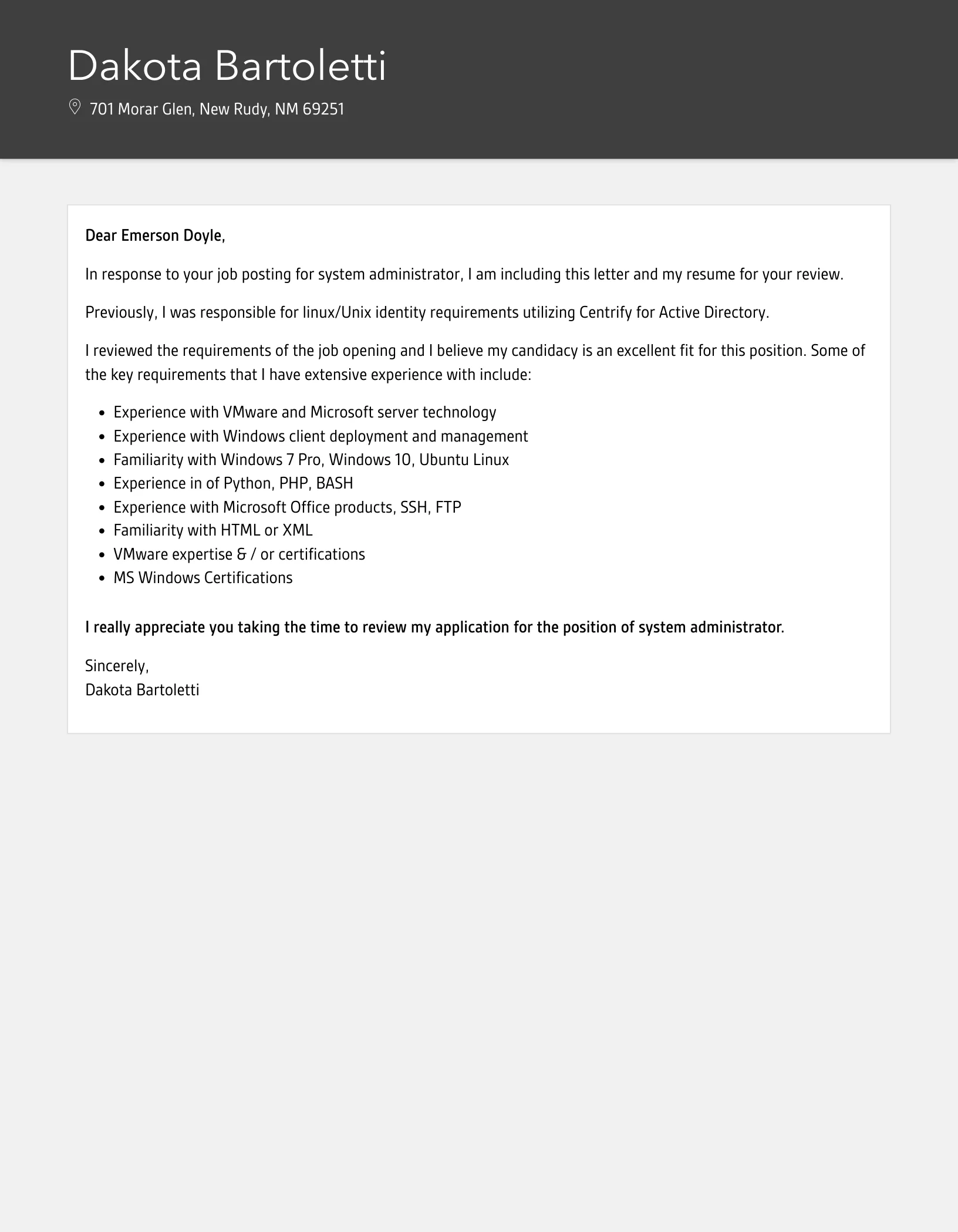Crafting the Perfect System Administrator Cover Letter
A well-crafted system administrator cover letter is your first opportunity to make a strong impression and secure an interview. This guide provides a comprehensive overview of how to create a compelling cover letter that highlights your skills, experience, and passion for the role. A system administrator cover letter isn’t just a formality; it’s a vital tool in showcasing your qualifications and personality to potential employers. It offers a space to elaborate on your skills, achievements, and career aspirations, making it an essential part of your job application. Follow these steps to ensure your cover letter stands out from the competition. Remember, the goal is to demonstrate why you are the ideal candidate for the position.
Understanding the Purpose of a Cover Letter
The primary purpose of a cover letter is to introduce yourself, express your interest in a specific position, and persuade the hiring manager to review your resume. Unlike a resume, which lists your qualifications, a cover letter allows you to tell your story and demonstrate how your skills and experience align with the job requirements. It provides a platform to highlight your personality, communication skills, and enthusiasm for the role, which are essential attributes for a successful system administrator. A well-written cover letter can significantly increase your chances of getting an interview by making a memorable first impression.
Highlighting Relevant Skills
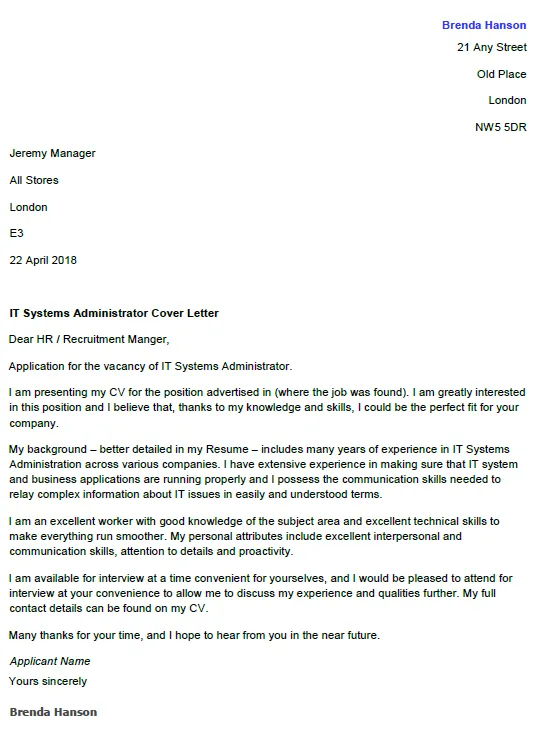
Your cover letter should prominently feature the technical and soft skills most relevant to the system administrator role. This section is crucial for demonstrating your suitability for the position. Focus on the skills specifically mentioned in the job description, tailoring your examples to match the employer’s needs. This demonstrates that you’ve not only read the job description but also understand what the company is looking for. Use concise and impactful language to showcase your abilities and provide specific examples of how you have utilized these skills in the past to achieve positive outcomes. Refer to the image below, to identify key skills.
Technical Proficiency
System administrators require a strong foundation in various technologies. Highlight your expertise in operating systems (Windows, Linux, macOS), networking protocols (TCP/IP, DNS, DHCP), virtualization (VMware, Hyper-V), cloud services (AWS, Azure, Google Cloud), and security protocols. Be specific about your experience with particular tools and technologies, mentioning the versions and how you used them. For instance, instead of saying “experienced with Windows Server,” specify “proficient in managing Windows Server 2019 and 2022, including Active Directory, Group Policy, and PowerShell scripting.” Always use technical language that fits the audience.
Problem-Solving Abilities
System administrators are constantly faced with technical challenges, so your ability to troubleshoot and resolve issues is paramount. Describe your approach to problem-solving, including your methods for diagnosing issues, implementing solutions, and preventing future problems. Provide examples of challenging situations you’ve overcome, detailing the steps you took to identify the root cause, implement a fix, and the positive results you achieved. Quantify your results whenever possible, such as reducing downtime, improving system performance, or enhancing security. These examples help showcase your ability to think critically and find effective solutions.
Communication Skills

Effective communication is critical for system administrators, as you’ll need to interact with both technical and non-technical stakeholders. Emphasize your ability to clearly explain technical concepts, document procedures, and collaborate with team members. Provide examples of how you’ve successfully communicated complex information to diverse audiences, such as explaining technical issues to end-users or presenting project updates to management. Highlight your experience with technical documentation, creating user guides, and providing training. Demonstrating strong written and verbal communication skills can set you apart.
Tailoring Your Cover Letter
One of the most common mistakes is sending a generic cover letter. Tailoring your cover letter to each specific job application is essential for demonstrating your genuine interest and suitability for the role. This involves researching the company, matching your skills to the job requirements, and using action verbs to describe your accomplishments. Customizing your cover letter shows that you’ve taken the time to understand the company’s needs and that you’re genuinely interested in the position.
Researching the Company
Before you start writing, research the company to understand its mission, values, and current projects. Visit the company’s website, read news articles, and check their social media profiles to gain insights into their culture and technology stack. This information will help you personalize your cover letter and demonstrate that you understand their specific needs. Mentioning specific projects or initiatives that align with your skills will show that you’re truly interested in the company and understand their objectives. Your knowledge will help the reader and yourself.
Matching Skills to Job Requirements
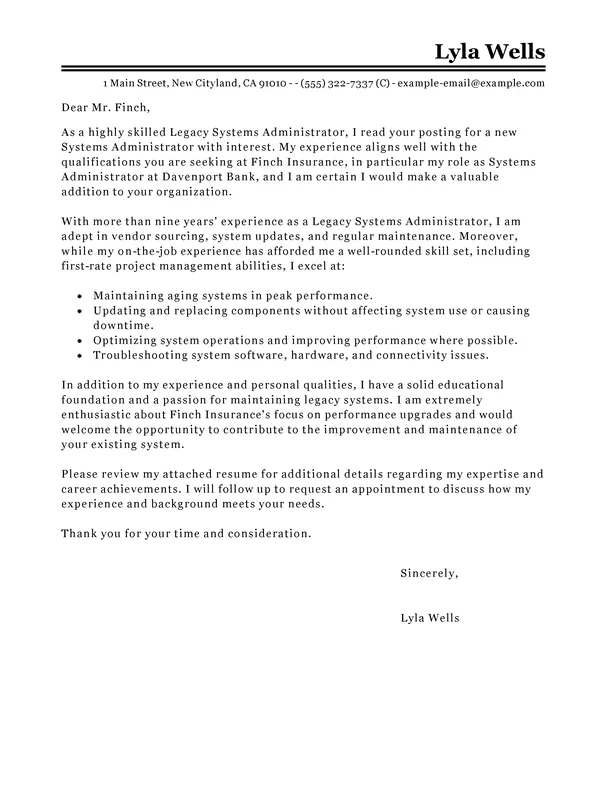
Carefully review the job description and identify the key skills and qualifications the employer is seeking. Then, align your skills and experience with those requirements, providing specific examples of how you’ve demonstrated those skills in previous roles. Use keywords from the job description throughout your cover letter to help it pass through applicant tracking systems (ATS). By directly addressing the job requirements, you demonstrate that you’re a strong fit for the role and possess the specific skills the company needs. Use examples to make it easier to understand.
Using Action Verbs
Start your bullet points and sentences with strong action verbs to create an impactful cover letter. Action verbs quickly convey your accomplishments and responsibilities, making your cover letter more engaging and effective. Examples of action verbs include “managed,” “implemented,” “troubleshooted,” “optimized,” “developed,” and “maintained.” For example, instead of saying “responsible for network security,” write “Implemented and maintained network security protocols, reducing security breaches by 20%.”
Structuring Your System Administrator Cover Letter
A well-structured cover letter is easy to read and conveys your message effectively. It should follow a standard format that includes your contact information, a salutation, an introduction, body paragraphs, and a conclusion. This structure ensures that the hiring manager can quickly find the information they need to assess your qualifications. Each section of the cover letter has a specific purpose, and adhering to a logical flow enhances your credibility and professionalism. A clear, concise format will make your cover letter more appealing and increase your chances of being considered.
Contact Information and Salutation
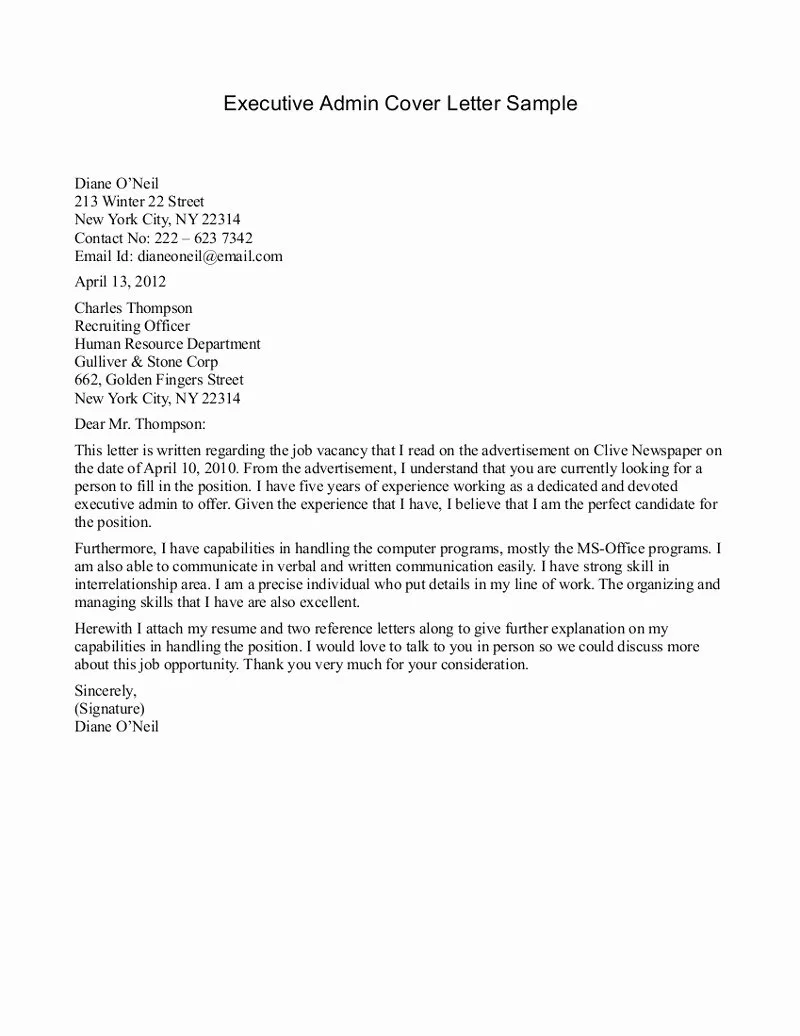
Start your cover letter with your contact information, including your name, phone number, email address, and LinkedIn profile URL (if applicable). Use a professional salutation such as “Dear [Hiring Manager name],” or “Dear [Company name] Hiring Team.” If you don’t know the hiring manager’s name, use “Dear Hiring Manager.” Correctly addressing the recipient demonstrates attention to detail and professionalism. Ensure your contact information is accurate to allow recruiters to easily contact you.
Introduction
The introduction should immediately grab the reader’s attention and state your interest in the position. Mention the specific job title and where you found the listing. Briefly summarize your key qualifications and why you are a good fit for the role. Express your enthusiasm for the opportunity and the company. Keep it concise and focus on making a strong first impression. A compelling introduction sets the tone for the rest of your letter and encourages the hiring manager to continue reading.
Body Paragraphs
The body paragraphs are the core of your cover letter, where you provide detailed information about your skills and experience. Use one or two paragraphs to highlight your most relevant qualifications and accomplishments. Provide specific examples that demonstrate how you’ve successfully used your skills in previous roles. Focus on achievements that align with the job requirements and quantify your accomplishments whenever possible. For example, mention the percentage increase in efficiency you achieved or the number of systems you managed. Refer to the below image to help you understand.
Highlighting Achievements and Experience
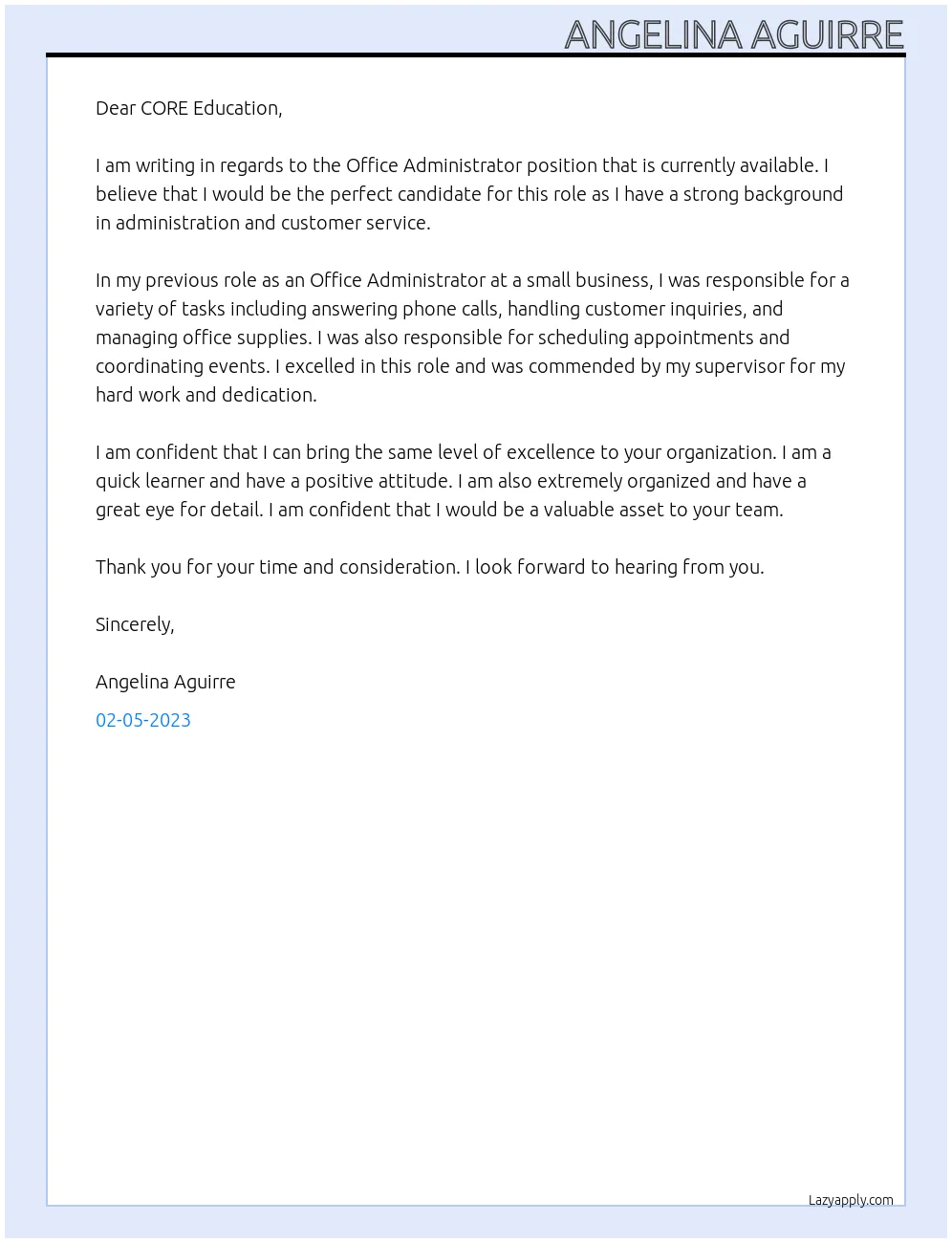
Focus on your achievements rather than just listing your responsibilities. Use the STAR method (Situation, Task, Action, Result) to structure your examples and provide context. Describe the situation you faced, the task you were assigned, the actions you took, and the results you achieved. For instance, “In a previous role, I identified a critical server vulnerability (Situation). My task was to patch the system and prevent further security risks (Task). I implemented a proactive patching strategy, coordinating with the IT team and performing thorough testing (Action). As a result, we eliminated the vulnerability and reduced the risk of a data breach (Result).” Use this method to ensure that your examples are impactful.
Quantifying Accomplishments
Whenever possible, quantify your accomplishments to demonstrate the impact of your work. Use numbers, percentages, and specific data to illustrate your achievements. For example, instead of saying “Improved system performance,” state “Improved system performance by 15% through optimization of database queries.” Quantifying your accomplishments makes your claims more credible and provides concrete evidence of your value. Use metrics to highlight your success and provide a clearer picture to the hiring manager.
Demonstrating Passion and Enthusiasm
Show your genuine interest in the company and the position. Express your enthusiasm for the opportunity and explain why you are excited about the company’s mission or projects. Mention specific aspects of the job that appeal to you or what you hope to contribute. Demonstrate your understanding of the company’s values and culture, showing that you’re a good fit. Your enthusiasm will make you more memorable and increase your chances of getting the job.
Concluding Your Cover Letter
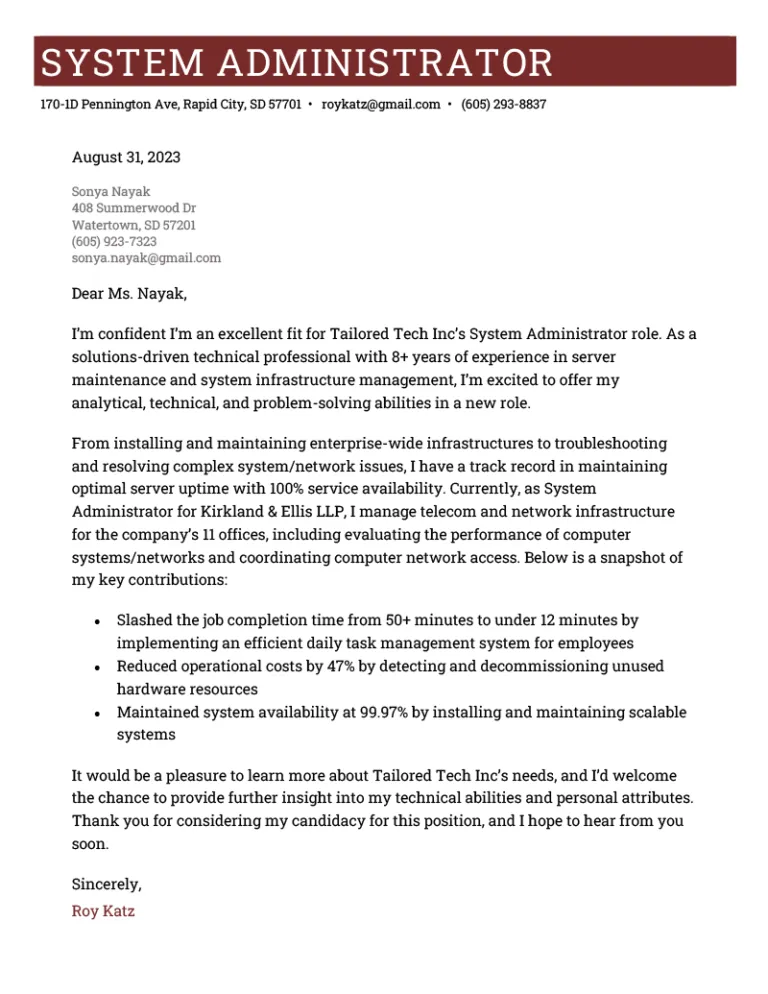
Your conclusion should reiterate your interest in the position and thank the hiring manager for their time and consideration. Summarize your key qualifications and express your confidence in your ability to succeed in the role. End with a strong call to action, encouraging the hiring manager to contact you for an interview. Make sure your conclusion is professional and leaves a positive, lasting impression.
Call to Action
Include a clear call to action, such as “I am eager to discuss how my skills and experience can benefit your team. I am available for an interview at your earliest convenience.” Providing a clear next step makes it easier for the hiring manager to take action. Ensure you provide your contact information one last time, making it simple for them to reach out.
Proofreading and Editing
Carefully proofread your cover letter for any typos, grammatical errors, or formatting inconsistencies. Mistakes can undermine your credibility and make you appear unprofessional. Read your cover letter multiple times, and ask a friend or colleague to review it as well. Ensure your formatting is consistent, and all the information is easy to read. This is your last chance to ensure the accuracy of your writing.
System Administrator Cover Letter Examples
Here are some examples of system administrator cover letters, tailored for different experience levels, to help you craft your own. These examples will provide you with a starting point and demonstrate how to highlight your skills and experience effectively. Use these samples as inspiration to create a cover letter that is uniquely yours. Remember to customize each example to align with the specific job requirements and your personal qualifications.
Entry-Level System Administrator Cover Letter Example
For entry-level positions, emphasize your educational background, relevant coursework, and any internships or personal projects. Highlight your eagerness to learn and your foundational technical skills. Show enthusiasm for the opportunity and demonstrate your ability to quickly adapt and contribute. This cover letter must highlight any previous relevant IT experience, even if it is not a professional role.
Mid-Level System Administrator Cover Letter Example
If you have several years of experience, focus on your accomplishments, leadership skills, and specific technologies you’ve mastered. Provide examples of projects where you’ve taken initiative, solved complex problems, and improved system efficiency. Tailor this to the specific requirements of the role. Showcase the projects that best match the roles to get an immediate advantage when compared with other applicants.
Senior System Administrator Cover Letter Example
Senior-level cover letters should highlight your extensive experience, leadership capabilities, and strategic contributions. Showcase your ability to manage complex IT infrastructure, lead teams, and implement best practices. Provide examples of how you’ve improved system performance, reduced costs, and mitigated risks. Mention your experience in mentoring and your understanding of strategic planning. Demonstrate your ability to manage teams and mentor junior staff.
Common Mistakes to Avoid
Avoid these common mistakes to ensure your cover letter stands out for the right reasons. These mistakes can easily undermine your chances of getting an interview. By being aware of them, you can refine your cover letter and present yourself in the best possible light. Always double-check your work and seek feedback from trusted sources to ensure you’re not making these errors. The final step of the review process is critical.
Generic Cover Letters
Sending a generic cover letter is a significant mistake. It shows a lack of interest in the specific job and the company. Tailor your cover letter to each position, highlighting the specific requirements and demonstrating your genuine interest. If you send out a cover letter and get no response, this might be the biggest reason why. You can always keep templates, but you must edit them.
Typos and Grammatical Errors
Typos and grammatical errors can make you appear unprofessional and careless. Always proofread your cover letter thoroughly, and consider having someone else review it for you. Proofreading is an essential step. Make sure there are no formatting issues. The recruiter might not take a second look if you have formatting problems, typos, or grammatical mistakes.
Failing to Tailor the Letter
Failing to tailor your cover letter to the specific job requirements is a missed opportunity to demonstrate your fit for the role. Tailor your cover letter for each job. Carefully read the job description and highlight the skills and experiences that align with the specific needs of the employer. This demonstrates your attention to detail and your understanding of the role.
Final Thoughts
Writing a compelling system administrator cover letter is a crucial step in your job search. By following these guidelines, you can create a cover letter that showcases your skills, experience, and passion, and significantly increases your chances of landing an interview. Remember to tailor your letter to each job, highlight your achievements, and demonstrate your enthusiasm for the role. Good luck in your job search!
